Stefanie Heeg and Ina Habermann currently have a research project about Swiss-British relations in the 17th and 18th centuries, and they have found a little gem that they would like to share.
This is work in progress and there are still many questions to be answered, but here is a brief
summary of what they know. You can download their PDF document here, or read it below.
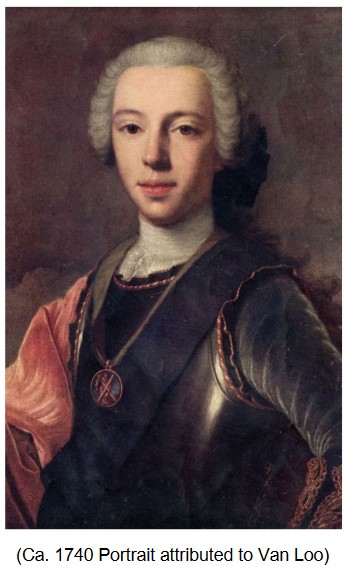
Charles Edward Stuart (1720-1788)
We have discovered that Charles Edward Stuart, the ‘Young Pretender,’ claimant to the British throne, and one of the most glamorous and wanted men in Europe, lived incognito in Basel for two years. ‘Bonnie Prince Charlie’ was an exiled Stuart prince, who was born and raised as a Catholic in Italy and is best known for leading the second Jacobite rising in 1745. In later years, he became quite a tragic figure; his ,problem‘ was that he did not die the hero’s death at the Battle of Culloden but began to outstay his welcome as an embarrassing anachronism.
There is a reason why Stuart is such a Romantic and ‘mythic figure’, known to many people all over Europe and beyond: Bonnie Prince Charlie plays a central role in Walter Scott’s very popular project of historical novels, designed to bolster Scottish national identity. He appears in Waverley, published in 1814 and focused on the Jacobite rising of 1745, and also in Redgauntlet (1824), which is set in 1765 and features a third, fictional Jacobean rising.
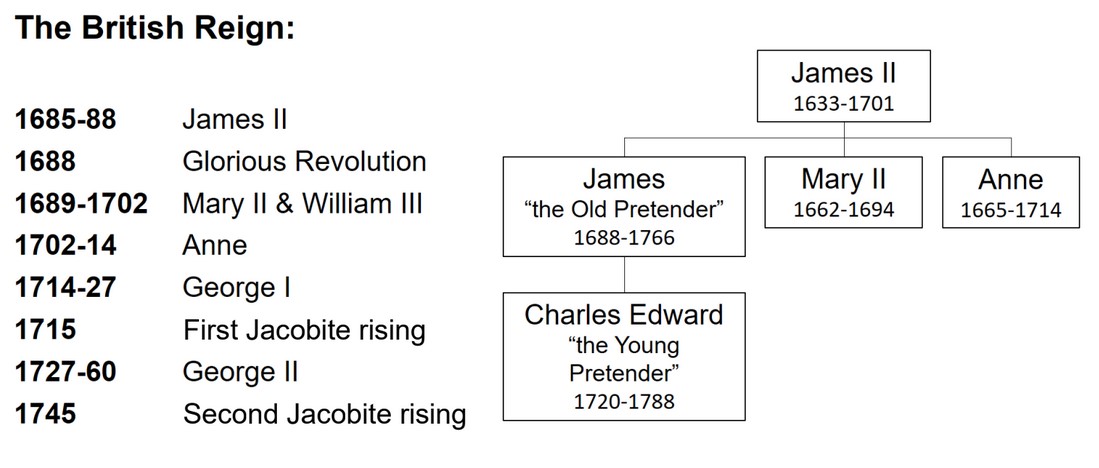
To brush up your history: James II was King of England, Scotland and Ireland from 1685 onwards. However, he was a Catholic, which was unacceptable to the powerful Protestants in the country. Their discontent culminated in the Glorious Revolution of 1688, when his protestant daughter Mary II and her husband William III, Prince of Orange, invaded England and forced James to flee to France. The Act of Settlement of 1701 then decreed that the crown could only pass to a Protestant monarch. Mary and William reigned together, but had no surviving children, leaving the crown to Mary’s protestant sister, Anne, who after 17 unsuccessful pregnancies, also died without an heir. Meanwhile, James’ Catholic son, also named James, had grown up in exile, and had been recognized as the rightful King by France and the Papal States amongst others. When Anne died and the government decided on the controversial crowning of a Hanoverian instead of him, he tried to regain the throne for the Stuarts, in the Jacobite rising of 1715. However, the invasion failed, and left him, once again, in exile. 30 years later his son, Charles Edward Stuart, stepped into his father’s shoes and tried to overthrow George II in the second Jacobite rising.
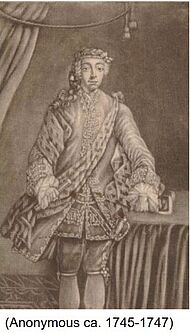
The Jacobite Rising of 1745
Charles Edward Stuart famously ventured to Scotland with the seven men of Moidart, and raised an army of 5000 highlanders. They had an initial victory against English forces at the Battle of Prestonpans, and marched towards the south. However, the French support was not forthcoming, and they had to retreat to Scotland, before they suffered their final defeat at the battle of Culloden in 1746. The prince managed to escape, dressed in women’s clothes, pretending to be the maid of Flora Macdonald.
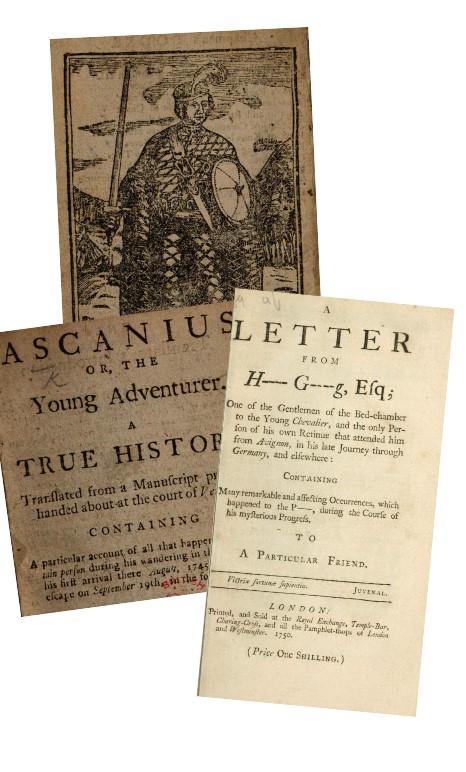
Wanted: Pretender in Exile
He was in exile in France, until the Treaty of Aachen in 1748, when France finally recognized
the current English crown. Suddenly having the young pretender in the country proved precarious. He was thus asked to leave France and from then on moved incognito from one place to the next, never
settling down for too long. His exodus and secretive living earned him an almost mythical status, with frequent sightings all over Europe. In his time in Basel he was sighted in Paris, Nottingham and supposedly took up the crown in Corsica. He used many different aliases, in order to evade the many
spies and anyone interested in the very high head bounties on him.
Stay in Basel: 1754-1756
So, what do we know about Charles Edward Stuart’s time in Basel? The first evidence comes from a letter written on the 29th of September in 1754 and reads:
“I am just arrived, my adress is L’oberge des trois Rois a Bale en Suisse, a Mr.
Thompson.”
We also know that he was accompanied by Clementina Walkinshaw and their daughter Charlotte and used the alias of W. Thompson physician and ‘gentillhomme Anglais.’
On the 25h of December of the same year he wrote another letter stating that he now stayed in:
“Basl in Suisse at ye Obere Caled ye Sauvage and under the name of Mr.
Lacroi.”
This is the Gasthof zum Wilden Mann, which today does not exist anymore, but used to be a very famous inn in Basel.
It’s a bit unclear for the remaining one and a half years of his stay where exactly he lived, but we know that in April and May in 1755 he paid rent to a certain Monsieur Mitz, and this is very likely for the house at Hebelstrasse 15, which is a rather ostentatious building.
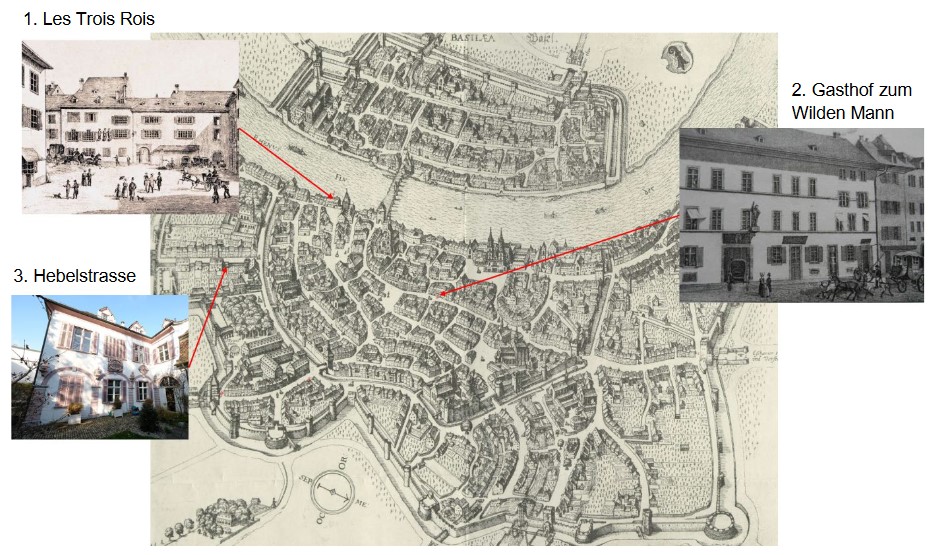
What more do we know about his time in Basel except for where he lived? This is also an area where there is still a lot of potential to find out more, especially if we get access to the Stuart papers, but in Basel there are absolutely no public records in the archives that we know of. We know, however, that he was struggling greatly with his alcoholism and also general health issues, for which he frequently asked for medication to be sent. He was also constantly asking his financer for more money, and went to great lengths and laments to achieve this, including lying about his mother being on death’s door, even though she had already gone through it years earlier. If he did receive money he then generously spent it in Basel and the surrounding areas on luxury goods, like wine and tableware, for which we have some receipts.
It’s also pretty certain that his true identity was not known by the wider public, but there
seem to have been several rumours:
“For a long time he was not known, but a print dealer had his portrait in his shop and everyone found the resemblance striking and began to believe that Mr. Tomson was the Prince.”
This is from the unpublished diary of Lord Elcho, which we hope to consult one day. There was also, apparently, a rumour that he had impregnated a young unmarried girl.
Also, a couple of years later, the famous Isaac Iselin and his best friend had a letter exchange about finding out that Mr. Thompson was actually the Prince, and they concluded:
“It has long been known in Basle that Sr. Thomson is Prince Edward and it has been known for longer that he is a fool.”
Some People he knew
And so here is a list of people that we know he engaged with during those two years:
• Burgermeister Samuel Merian 1685-1760
• Surgeon Isaac Widmer 1674-1764
• Municipal physician Dr. Johannes Buxtorf-Zwinger 1702-1768
• Mathematician Johann Bernoulli II 1710-1790
• Mathematician Daniel Bernoulli 1700-1782
• Apothecary Hiernoymous Bernoulli 1669–1760
• Pastor Jean Rodolph Ostervald 1687-1764
• Three more unidentified persons
It’s important to note that these were truly the highest circles of Basel, resulting in a lot of open questions about their relationship with him.
It is also unclear how many of these people knew his true identity, but it seems likely that at least Johannes Buxtorf-Zwinger was inaugurated as well as Johannes Bernoulli II.
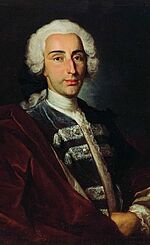
Johannes Bernoulli II
We know this because Johannes Bernoulli II very conveniently kept a list of notable people he knew,
which includes:
“Prince Edward, who spent several years incognito in Bale under the name of Chev. Thomson.”
There are also five letters by him about the Prince which further confirm this.
Sudden Departure
And then, suddenly, he left. On the 28th of June 1756 he writes:
“As Mr. Buxtorf advised me to take mineral waters, and not being determined to return to Basle for some time, I beg you to make my apologies to Mr. Burgomaster Merian.”
And one day later, he writes again:
“Iff there should happen that Letters Came for me after ye Departure; you are to give directions, they should be delivered to Doctor Buxtorf to whom you are to ask his adress.”
We have no idea why he left, and we’re hoping to find evidence to explain his sudden departure, but it’s clear that it was unplanned and very hectic, so something must have happened that triggered it.
Perhaps a bounty hunter found him, or someone in Basel, who was not in his trusted circle, found out who he was, but as of now, it remains one of the big mysteries we are trying to solve.
And so - Charles Edward Stuart was on the run again, with a new identity, looking for a new place to hide:
“What can a bird do that has not found a right nest? It must flit from bough to bough.”
(Charles Edward Stuart, 1749)
Sources
Amulree, Basil William Sholto Mackenzie, and Felix. Staehelin. Prince Charles Edward Stuart's Visit to Basle, 1754-1756. 1948-1950. University of Stirling Library Amulree Collection.
Bernoulli, Carl Albrecht. Gedenkbuch der Familie Bernoulli zum 300. Jahrestage ihrer Aufnahme in das Basler Bürgerrecht, 1622-1922. Helbing & Lichtanhahn, 1922.
McLynn, Frank. Bonnie Prince Charlie: Charles Edward Stuart. Pimlico, 2020.
Staehelin, Felix. Der jüngere Stuartprätendent und sein Aufenhalt in Basel 1754-1756. Helbing & Lichtenhahn, 1949.
